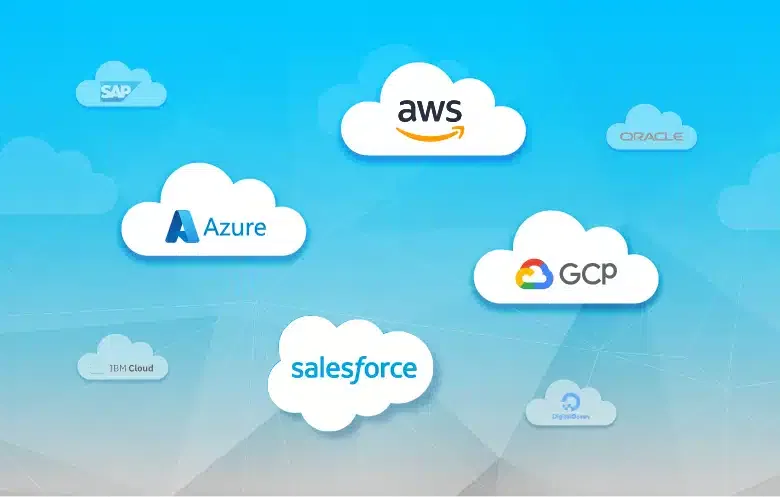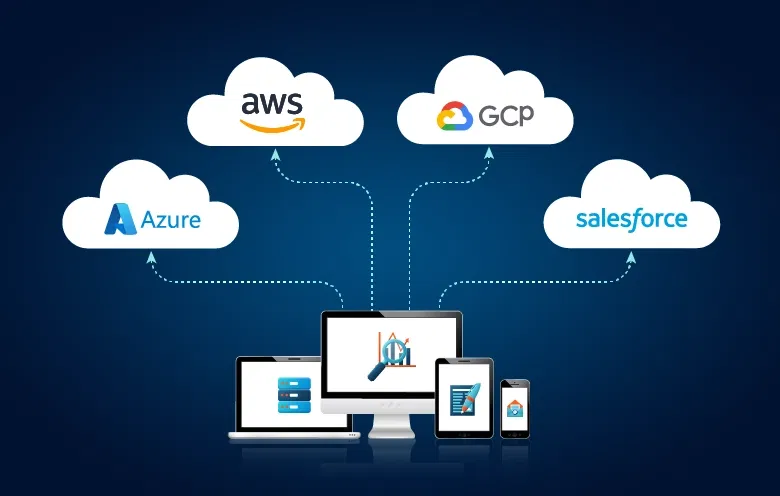Organizations strive to gain scalability, cost efficiency, and agility. However, businesses that rely on data stored on premises, have limited visibility of their operations and access to their resources. There are several challenges faced by companies with on-premises infrastructure:
- Limited scalability
- Data security concerns
- Remote work limitations
- Compliance headache
Businesses are evolving to serve customers’ needs. Hence, to offer better services and products, it has become imperative to leverage the benefits of cloud adoption.
What is cloud adoption?
Cloud adoption is the process of an organization moving its business operations, applications, and data storage to a cloud computing platform. In simpler terms, it’s migrating from using your own physical servers to using computing power, storage, and other IT resources that are provided over the internet.
Benefits of cloud adoption
Improved scalability and agility
Customer and market demand constantly fluctuate. Companies can easily scale compute power, storage capacity, and other services up or down depending on this fluctuation. This empowers organizations to react swiftly to market changes, seize new growth opportunities, and eliminate the need for significant upfront infrastructure investments.
Reduced IT costs
Traditional infrastructure investments involve substantial capital expenditure on hardware, software licenses, and data center maintenance. With cloud adoption, businesses can leverage pay-as-you-go model. This allows them to pay according to their resource consumption. This translates to significant cost savings, freeing up capital for core business activities and innovation.
Improved security
Cloud services providers leverage state-of-the-art security infrastructure to safeguard data and applications. This ensures efficient risk mitigation and data integrity.
Increased collaboration and productivity
Often, businesses located in different regions face challenges in sharing crucial documents. Geographically dispersed teams can seamlessly access and share information in real time with cloud in place. This facilitates efficient project management and improved collaboration.
Business continuity and disaster recovery
In the times like natural calamities or cyberattacks, traditional systems are more vulnerable, leading to data loss. Cloud platforms offer built-in disaster recovery features, replicating data across geographically separated locations. This ensures data accessibility and business continuity even in the event of unforeseen disruptions, minimizing downtime and potential revenue loss.
Although, cloud comes with myriads of benefits, there are some challenges that companies face with cloud adoption.
Challenges of cloud adoption and how to address them
Security concerns
Organizations need to choose a reputable cloud provider with a proven track record of robust security practices and implement strong security protocols internally, such as encryption and access controls.
Integration complexity
Integrating legacy systems with modern cloud technologies can be intricate. Develop a comprehensive integration plan that leverages APIs and integration platforms to ensure seamless data flow and business process continuity.
Compliance considerations
Organizations need to conduct a thorough compliance assessment to understand relevant regulations and select cloud service providers that offer compliant services.
Key cloud adoption models
| Public cloud |
|
Sixty seven percent of respondents favored private cloud services. – Yankee Group |
| Private cloud |
|
45% of businesses use a private cloud. – Research by O’Rielly |
| Hybrid cloud |
|
According to AAG-IT, 80% of businesses use hybrid clouds, combining public and private cloud infrastructure. |
| Multi cloud |
|
90% of large enterprises and 92% of small organizations use a multi-cloud approach. – CRN |
| Poly cloud |
|
Suggested: A complete guide on cloud-based applications for technology leaders
How to implement a cloud adoption strategy
1. Cloud assessment and planning
It is important to conduct a comprehensive cloud readiness assessment to understand the current IT infrastructure, application suitability for cloud migration, and business goals. Outline a plan that includes:
- Cloud migration strategy
- Workload prioritization
- Cloud service selection (IaaS, PaaS, SaaS)
- Identity and Access Management (IAM) best practices
- Disaster recovery protocols
2. Cloud migration and integration
Leverage data migration tools and techniques to ensure data integrity and minimize downtime. Integrate phased approach using APIs and integration platform as a service (iPaaS) to ensure seamless data flow and business process continuity.
3. Cloud management and governance
Implementing cloud governance is important to ensure security, compliance, and cost effectiveness. Utilize cloud management tools for resource provisioning, cost monitoring, performance optimization, and automation of routine tasks. Establish a cloud center of excellence (CCOE) to foster knowledge sharing and best practices across the organization.
For better cloud adoption, businesses must leverage cloud consulting services.

Cloud strategy and assessment workshop
The adoption of cloud-based infrastructure by enterprises is increasing greatly. However, a lot of enterprises are still reluctant to adopt a cloud strategy due to lack of skills or knowledge.
Industry use cases of cloud services
Manufacturing
- Optimize production processes: With real-time data offered by cloud adoption solutions, manufacturers can identify bottlenecks, optimize machine performance, and schedule maintenance proactively.
- Streamline supply chain management: Manufactures can gain real-time visibility into supplier performance, inventory levels, and shipment tracking. Cloud services enable them to have better collaboration with suppliers, optimize inventory, and minimize disruption throughout the supply chain.
- Gain real-time insights into operations: Manufacturers can use cloud analytics platforms to turn operational data into actionable insights. They can use these insights to monitor production performance, identify areas for improvement, and make data-driven decisions to optimize overall operations.
- Predictive maintenance: Cloud analytics help manufacturers to analyze sensor data from equipment. They can identify potential equipment failures before they occur, preventing costly downtime and ensuring smooth production runs.
Logistics
- Track shipments in real time: Businesses can gain real time visibility into shipment location, status, and estimated arrival time. This enhances transparency throughout the delivery process, improves customer satisfaction, and facilitates proactive exception handling.
- Optimize delivery routes: Companies can use cloud analytics to analyze traffic patterns, weather conditions, and other factors to optimize delivery routes. They can minimize delivery times, reduce transportation costs, and improve overall logistics efficiency.
- Manage inventory level efficiently: Cloud-based inventory management systems offer real-time visibility into stock levels across warehouses and distribution centres. Logistic companies can optimize inventory allocation, minimize stockouts, and fulfill orders efficiently.
Healthcare
- Secure storage and access to electronic health records (EHR): Cloud platforms provide secure storage and access to EHRs, allowing authorized healthcare providers to access patient data anytime, anywhere. This fosters better care coordination and improves patient outcomes.
- Better collaboration among healthcare providers: Cloud solutions facilitate seamless collaboration between doctors, nurses, specialists, and other healthcare professionals involved in a patient’s care.
- Innovative healthcare applications: Healthcare professionals can leverage cloud-based applications such as, telehealth platforms, remote patient monitoring systems, and artificial intelligence-powered diagnostics tools.
- Improved patient management: Cloud-based solutions automate administrative tasks such as appointment scheduling, billing, and claims processing. It can also help with secure online access to medical records, appointment scheduling, and communication with healthcare providers.
Retail
- Seamless omnichannel customer experience: Retailers can provide a consistent shopping experience with online and offline cloud-based platforms. This helps customers to easily access product information, track orders, and make purchases anywhere and anytime.
- Manage inventory levels across multiple channels: Cloud-based inventory management systems provide real-time visibility into stock levels across all stores and online platforms. This enables retailers to optimize inventory allocation, minimize stockouts, and fulfill orders efficiently.
- Personalized marketing and product recommendation: Retailers can collect and analyze vast amount of customer data that can be easily stored and managed in the cloud. These insights power personalized marketing campaigns, targeted product recommendations, and dynamic pricing strategies, ultimately enhancing customer engagement and driving sales.
Finance
- Enhanced security: Sensitive financial data is critical to protect. Financial institutes can leverage cloud adoption strategy for robust security measures such as, data encryption, access controls, and intrusion detection systems.
- Fraud detection: With cloud analytics, financial institutes can monitor transactions and customer interactions.
Cloud migration guide
Step1: Migration preparation
Step 2: Planning and strategizing
Step 3: Design
Step 4: Migration and validation
Step 5: Operate and optimize
Best tips and tricks for successful cloud adoption
- Define a business case: It is imperative for businesses to define the purpose of leveraging cloud adoption services. Identify clear objectives, such as cost savings, increased productivity, or improved customer satisfaction.
- Start small and scale gradually: Companies need to carry a full assessment of their application environment, data needs, and infrastructure. This helps in determining cloud adoption readiness. However, it is important to start small. Take one use case and focus on adopting cloud at a smaller scale. This helps in identifying and mitigating challenges efficiently.
- Select a trusted cloud consulting services provider: Evaluate the provider’s security practices, compliance certifications, scalability, and customer support reputation before selecting a cloud service.
- Focus on security: Choose a cloud consulting services provider that emphasizes on security measures, such as, encryption, access controls, and regular penetration testing to safeguard sensitive data.
- Monitor and optimize cloud usage: Identify underutilized or idle resources. By monitoring cloud usage, companies can also track their budget and gain deeper insights into how their cloud spend is being used.
Leverage the benefits of cloud adoption solutions
According to Rackspace, 88% of companies save money by running services in the cloud. Modern businesses have realized the value of cloud adoption. However, cloud migration isn’t an easy process and requires technical expertise as well as experience. Hence, it is crucial to contact cloud consulting services providers to analyze requirements and tools that can support your business use case.
At Softweb Solutions, we have a team of certified cloud consultants with a proven track record of providing best-in-class cloud services. Contact us to know more.



